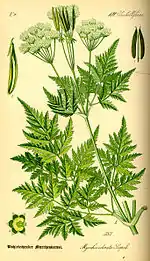Cicely
Myrrhis odorata, with common names cicely (/ˈsɪsəli/ SISS-ə-lee), sweet cicely,[2] myrrh, garden myrrh, and sweet chervil,[3] is a herbaceous perennial plant belonging to the celery family Apiaceae. It is the only species in the genus Myrrhis.[4]
| Cicely | |
|---|---|
 | |
| Flowers of Myrrhis odorata at the Giardino Botanico Alpino Chanousia | |
| Scientific classification | |
| Kingdom: | Plantae |
| Clade: | Tracheophytes |
| Clade: | Angiosperms |
| Clade: | Eudicots |
| Clade: | Asterids |
| Order: | Apiales |
| Family: | Apiaceae |
| Subfamily: | Apioideae |
| Tribe: | Scandiceae |
| Subtribe: | Scandicinae |
| Genus: | Myrrhis Mill. |
| Species: | M. odorata |
| Binomial name | |
| Myrrhis odorata | |
| Synonyms[1] | |
| |
Etymology
The genus name Myrrhis derives from the Greek word myrrhis [μυρρίς], an aromatic oil from Asia. The Latin species name odorata means scented.[5][6]
Description

Myrrhis odorata is a tall herbaceous perennial plant growing to 2 m [6 ft 6 in] tall, depending on circumstances. The leaves are fern-like, 2-4-pinnate, finely divided, feathery, up to 50 cm long, with whitish patches near the rachis. The plant is softly hairy and smells strongly of aniseed when crushed. The flowers are creamy-white, about 2–4 mm across, produced in large umbels. The flowering period extends from May to June.[7] The fruits are slender, dark brown, 15–25 mm long and 3–4 mm broad.[8][9]
Distribution and habitat
Myrrhis odorata is native to mountains of southern and central Europe, from the Pyrenees to the Caucasus. It has been introduced and naturalized elsewhere in cultivated areas, woodland margins, roadside verges, river banks and grassland.[5][10][11] In the British Isles it is most abundant in northern England and eastern Scotland.[10]
Cultivation and uses
In fertile soils it grows readily from seed, and may be increased by division in spring or autumn.[12]
Its leaves are sometimes used as a herb, either raw or cooked, with a rather strong taste reminiscent of anise. The roots and seeds also are edible. Additionally, it has a history of use as a medicinal herb.[5]
Like its relatives anise, fennel, and caraway, it can also be used to flavour akvavit.[13] Its essential oils are dominated by anethole.[14]
References
- "Myrrhis odorata (L.) Scop.", Plants of the World Online, Royal Botanic Gardens, Kew, retrieved 2021-07-04
- Chisholm, Hugh, ed. (1911). . Encyclopædia Britannica. Vol. 6 (11th ed.). Cambridge University Press. p. 353.
- USDA GRIN Taxonomy, retrieved 9 April 2017
- "Myrrhis Mill.", Plants of the World Online, Royal Botanic Gardens, Kew, retrieved 2021-07-04
- M. Grieve A Modern Herbal
- Germot Katzers Spice Pages
- Plants for a future
- Stace, C. A. (2010). New Flora of the British Isles (Third ed.). Cambridge, U.K.: Cambridge University Press. p. 450. ISBN 9780521707725.
- Flora of Northern Ireland
- "Online Atlas of the British and Irish Flora". Retrieved 2 May 2017.
- Linnnaeus
- Royal Horticultural Society
- The Gourmet Food & Cooking Resource
- Wild Flower Finder
 Data related to Myrrhis at Wikispecies
Data related to Myrrhis at Wikispecies Media related to Myrrhis odorata at Wikimedia Commons
Media related to Myrrhis odorata at Wikimedia Commons